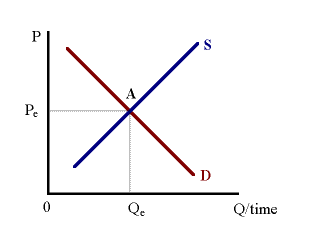Shifts in supply (resulting from changes in any of the exogenous variables)
and the impact on equilibrium price and quantity is demonstrated in the diagram
below (just move the mouse-pointer over any of the blue spheres to see changes):

|
|
The supply equation may be written using the following general function form:
Qs = f (Px; Technology, Factor Prices, Taxes & Subsidies, # of producers),
where 'Px' represents the "own" price of the good supplied. The variables listed after the semi-colon represent other exogenous variables that affect the quantity supplied for a particular good. Factor prices in this list includes wages, rents, rental cost of capital (interest), and normal profits.
Changes in own price (due to surpluses or shortages) will lead to a movement along the supply curve. In contrast changes in any of the exogenous variables will lead to an inward or outward shift in supply. In general, any shock that leads to lower costs of production (technological improvements, lower factor prices, lower taxes, or increased subsidies) will lead to an outward shift in supply (holding the demand of that good constant). This outward shift will create a surplus of that good at prevailing market prices. This surplus leads to a decrease in market prices with corresponding movements along the demand and supply equations until a new equilibrium price and quantity are established.
We can examine this type of shock in the diagram to the right. The market in this example will be for Cell Phones. The exogenous shock will be an improvement in production technology. Given this shock, producers will attempt to produce and sell more Cell Phones at each and every price. This reaction will lead to a surplus of this good and thus a decrease in the market price. As the market price falls, consumers increase their rate of consumption (an increase in quantity demanded) and producers reduce the rate of production (a reduction in quantity supplied) along the new supply schedule. The net result will be an increase of quantity and reduction in equilibrium price.
Higher costs of production will have the opposite effect (a shortage leading to higher prices) as shown below:We can examine this type of shock in the diagram to the left. The market in this example will be for Single Family Homes. The exogenous shock will be an increase in the price of land. Given this shock, producers will begin to build and offer for sale fewer new homes at each and every price. This reaction will lead to a shortage of housing and thus an increase in the market price. As the market price increases, consumers decrease their rate of consumption (a decrease in quantity demanded) and producers increase the rate of production (a reduction in quantity supplied) along the new supply schedule. The net result will be a decrease in equilibrium quantity and an increase in equilibrium price.
Shifts in supply (resulting from changes in any of the exogenous variables)
and the impact on equilibrium price and quantity is demonstrated in the diagram
below (just move the mouse-pointer over any of the blue spheres to see changes):

|
|